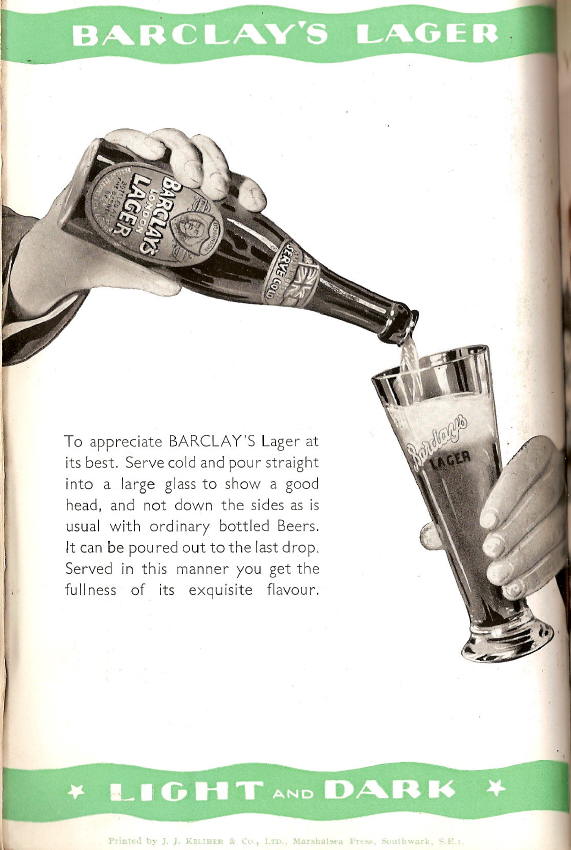
My blog hasn't been living up to its title. There's barely been a mention of Barclay Perkins so far. My apologies. I aim to put things right today. I did start telling my kids about early British lager, but they preferred to do their homework. You'll have to do. It's fascinating stuff. Really.
To those of us used to piss-weak British lagers with pseudo-Germanic names brewed from adjuncts in Northampton, Barclay Perkins pioneering efforts between the wars may come as a surprise.
Barclay Perkins picked an odd time to start experimental lager brewing: during WW I. Which could be why, rather than coming up with some fake German name like Grunhalle, they called their beer London Lager. I was shocked to find lager mentioned in the London publicans' price-fixing agreement of 1917.
Here are the shocking features of lagers in the 1920's and 1930's:
They were all malt. At a time when grists of their standard Bitter and Mild were 10% maize and 20% sugar.
- They weren't all pale in colour. Barclay Perkins brewed three lagers: Pale Draught, Pale Export and Dark or Munich.
- They were the same strength as continental lagers. Pale Draught: 1044; Pale Export: 1050; Munich: 1057. These are comparable to their equivalent draught ales: XLK (Bitter) 1046, PA (Best Bitter) 1053, KK (Burton) 1056.
 Though initially the quantities they brewed were quite small (see table of lager production to the left), only about 2,200 barrels in the first year of serious production, 1921, it quickly increased and was already up 6,500 barrels a year later. As Barclay Perkins were brewing around 200,000 barrels a year in total, it only amounted to around 3% of their production. But remember, at the time lager's share of the market was 1% at most.
Though initially the quantities they brewed were quite small (see table of lager production to the left), only about 2,200 barrels in the first year of serious production, 1921, it quickly increased and was already up 6,500 barrels a year later. As Barclay Perkins were brewing around 200,000 barrels a year in total, it only amounted to around 3% of their production. But remember, at the time lager's share of the market was 1% at most.It's surprising how much effort they went to both in brewing and marketing their lager. A special brewhouse was contructes and a Danish brewer brought in to supervise operations. Their in-house magazine (The Anchor) is full of adverts, like the one at the top of this post. They must have seen a big future for lager in Britain. When ale brewing stopped at the end of the sixties, following their merger with Courage, lager continued to be brewed at the Park Street site for several more years.
If you want to see exactly how the lagers were brewed (I admit there are likely to be very few of you), here are logs for the Draught and Dark lagers. Interestingly (however inappropriate for most of you the use of the word in this context) the Dark Lager was coloured using roasted barley. The low fermentation temperatures - 25 to 30º F cooler than for their ales, and the secondary ferementation just above freezing, are indications of the level of authenticity. I would love to be able to make a comparison with the production methods of modern Carling or Tennent's. How long do you think they lager them? A week? Do they even bother?












































































5 comments:
You will have to accept my word that this is beer blogging of the highest order. Would it be asking for a secret to be told if I asked how you got these ledgers?
Alan
A Good Beer Blog
Glad to hear you like it.
I photographed the ledgers in question in the London Metropolitan Archive. They have almost complete brewing records for three of the largest London breweries - Barclay Perkins, Whitbread and Truman for the period 1815 to 1970. It's a real trasure trove. On my last visit I took 450 photographs. I wish I could get to it more regularly.
I still haven't done anything with the Truman brewing records I photographed. As I work my way through them, they are bound to inspire topics here.
Dark English lagers? Interesting
Don't worry Ron, I am finding your posts extremely interesting!
Stonch - I was more shocked by the all-malt bit than by some being dark. Good quality ingredients, authentic brewing process - doesn't sound like British lager at all.
Jim - I had wondered how many people were interested in this stuff. The count is now up to about five. If I include myself.
Post a Comment